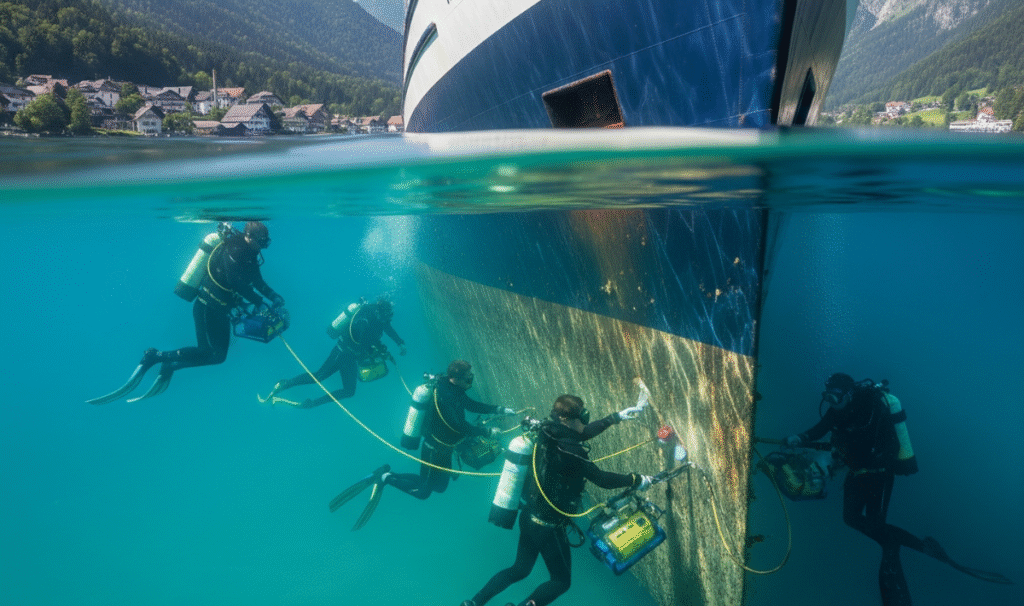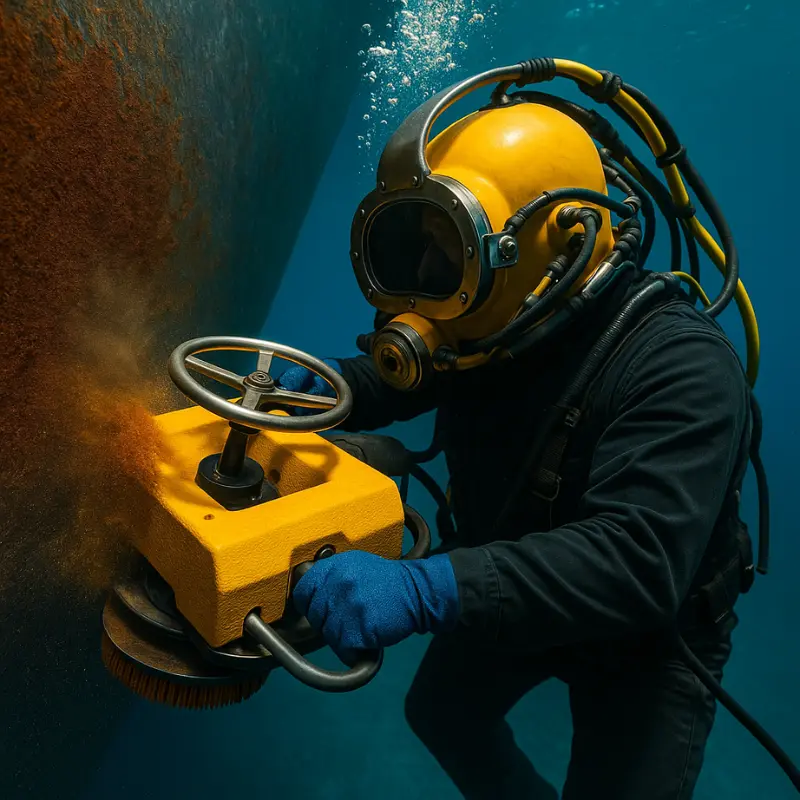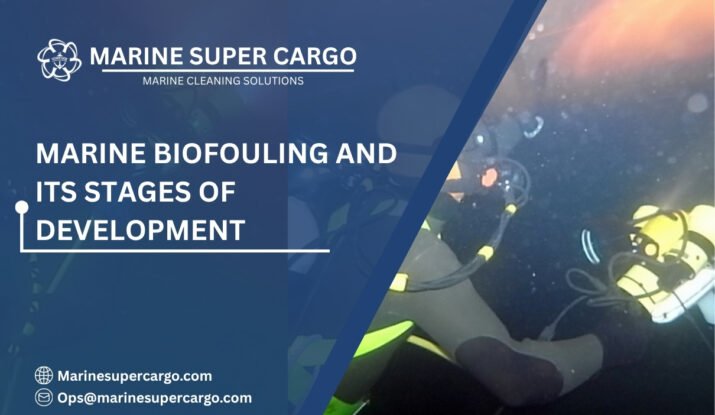Picture a brand-new ship gliding smoothly over calm waters, its freshly painted hull slicing through the sea like a hot knife through butter. Fast forward a few weeks, and unseen ocean hitchhikers—microbes, algae, barnacles—settle on its surface. The once-smooth hull now fights resistance, guzzles fuel, and risks violating international regulations. This is the slow, stubborn, and costly process of Marine Biofouling.
In this article, we’ll walk through what marine biofouling is, its stages of development, why it’s a threat to shipping, and what innovative strategies you can employ to keep it under control.
What is Marine Biofouling?
Marine biofouling is the accumulation of organisms—ranging from microscopic bacteria to large shellfish—on submerged ship surfaces. It’s like graffiti on a ship’s hull, only it comes from the ocean.
The consequences are not only aesthetic but deeply impactful:
- Increased drag leading to 20–40% higher fuel consumption.
- Structural stress from calcareous organisms like barnacles and tubeworms.
- Spread of invasive species across global waters, flagged by IMO.
- Higher emissions and non-compliance with MARPOL guidelines.
When we understand Marine Biofouling, we can strategize effective cleaning, smarter coatings, and preventive maintenance.

Why Biofouling is Such a Big Problem
Think of it this way—biofouling is like rust on an athlete’s sprint spikes. It doesn’t just slow you down; it makes you burn energy inefficiently. For ships:
- Fuel Costs: Fouled hulls increase operational fuel costs significantly.
- Environmental Harm: More drag means higher CO₂ and NOx emissions.
- Compliance Issues: Ports under IAPH and nations like New Zealand check hull biofouling before entry.
- Coating Damage: Biofouling shortens the life of expensive anti-fouling coatings.
Without consistent management, Marine Biofouling transforms from a minor nuisance to a profit-drainer.
The Five Stages of Marine Biofouling Development
Marine biofouling doesn’t happen all at once—it unfolds in a sequence, much like weeds overtaking a garden. Let’s break down the five stages.
Stage One: Conditioning Film Formation
- Immediately after immersion, organic molecules and proteins settle on the hull.
- This invisible film is like double-sided tape, preparing the surface for microbes.
- Impact: No drag yet, but the stage is set.
Stage Two: Microbial Colonization (Microfouling)
- Bacteria and diatoms (microscopic algae) colonize the conditioning layer.
- They create biofilms—slimy, sticky sheets across the hull.
- Even this early layer can increase drag by 5–10%.
Stage Three: Algal Growth
- Larger algae species form green or brown mats on top of biofilms.
- These algae increase friction and prepare space for bigger organisms.
- Result: Noticeable performance drops, requiring early cleaning.
Stage Four: Settling of Invertebrates (Macro Fouling)
- Barnacles, mussels, tunicates, and sponges attach permanently to the hull.
- Their shells and structures act like speed bumps underwater.
- Drag increases up to 40% if left unchecked.
Stage Five: Mature Fouling Community
- At this point, the hull resembles a mini-reef, complete with diverse organisms.
- Extremely difficult and costly to clean without drydocking.
- Massive compliance and efficiency risks.
Each of these Marine Biofouling stages highlights the importance of early intervention.
Read also: Underwater hull cleaning in the UAE.
Organisms Involved in Biofouling
When it comes to marine biofouling, not all organisms are created equal. The types of species that attach to a ship’s hull determine how quickly drag builds up, how much fuel efficiency is lost, and what cleaning strategies are required. Broadly, fouling organisms are grouped into two categories: microfoulers and macrofoulers.
- Microfoulers:
These are the earliest settlers on a clean hull surface, often invisible to the naked eye. They include bacteria, diatoms, and thin slime layers that create a sticky biofilm. While microfouling might seem minor, it sets the stage for larger organisms to attach more firmly. Left unchecked, this layer can quickly escalate into more severe forms of fouling.
- Macrofoulers:
These are the heavyweights of hull fouling—organisms like barnacles, mussels, tubeworms, sponges, and seaweed. Once they establish themselves, resistance increases dramatically, making it much harder for vessels to maintain speed. Removal often requires mechanical or robotic cleaning systems rather than simple brushing.
- Barnacles:
- Among macrofoulers, barnacles are the most infamous. Their hard calcium shells cling stubbornly to hulls and form dense colonies over time. Research shows that mature barnacle infestations can increase a ship’s fuel consumption by up to 60%, leading to higher operating costs and carbon emissions.
Understanding which organisms are involved in biofouling helps operators tailor their hull cleaning methods—whether through preventive coatings, robotic cleaning, or regular inspections. This knowledge not only saves fuel but also ensures compliance with IMO biofouling regulations while protecting marine ecosystems.

Compliance and Global Guidelines
International bodies have designed strict frameworks to curb biofouling.
- IMO Guidelines: Focus on preventing invasive species spread.
- MARPOL Annex V: Prohibits the unsafe disposal of fouling waste.
- Port Authorities (IAPH): Ports like Sydney and Auckland enforce regular inspections.
- Safety (IMCA): Ensures divers and cleaning teams operate under global safety standards.
Failure to control Marine Biofouling risks fines, detentions, and reputational damage.
Read also: Underwater hull cleaning in the UK.
Costs and Risks for Ship Owners
For ship managers, allowing unchecked fouling equals burning money.
- Fuel penalties between 10 and 40%.
- Frequent dry-docking and coating re-application.
- Vessel speed reductions affect delivery schedules.
- ESG pressures as carbon reporting becomes mandatory.
A fouled hull is literally money slipping into the sea.
Solutions to Marine Biofouling
No ship operator can avoid fouling entirely—but it can be controlled.
- Anti-Fouling Coatings: Modern biocidal and silicone-based coatings prevent organism settlement.
- Regular Inspections: Early-stage fouling is cheaper and easier to clean.
- Diver Cleaning: Human divers handle spot cleanings in smaller ports.
- Robotic Hull Cleaning: Automated crawlers clean extensively while capturing fouling waste.
- Waste Disposal Systems: Keep in line with MARPOL Annex V environmental obligations.
By mapping solutions to fouling stages, you can manage costs effectively.
Future Innovations in Hull Care
The maritime industry is rapidly moving toward greener, smarter technologies to combat Marine Biofouling, a challenge that costs billions annually in fuel waste, emissions, and maintenance. Traditional cleaning methods are giving way to advanced solutions designed for efficiency, safety, and sustainability.
- AI-Driven Predictive Systems: Artificial intelligence is revolutionizing hull care by analyzing vessel speed, fuel consumption, water temperature, and voyage data. These predictive systems can forecast when Marine Biofouling will become problematic, allowing operators to schedule cleaning before heavy fouling develops. This not only cuts costs but also prevents unnecessary downtime.
- Nanostructured Coatings: Scientists are testing next-gen coatings with microscopic surface textures that naturally repel fouling organisms. Unlike older paints that relied on toxic biocides, these coatings are eco-friendly, reducing the settlement of barnacles, algae, and other Marine Biofouling culprits while extending the time between cleanings.
- Autonomous Hull Robots: Robotic cleaners are being designed to work autonomously during port calls, scrubbing hulls without human divers. These machines can clean efficiently, collect debris, and ensure compliance with environmental rules—all while minimizing downtime. Their precision makes them ideal for tackling persistent Marine Biofouling without damaging protective coatings.
The future of managing Marine Biofouling lies at the intersection of smart data, eco-innovation, and automation. By adopting these technologies, ship operators can expect cleaner hulls, lower fuel bills, and stronger compliance with IMO and MARPOL standards—all while reducing their environmental footprint.
🌊 Ocean Hull Insurance on the Rise 🚢
— Marine Super Cargo (@Marinsupercargo) September 9, 2025
The International Union of Marine Insurance (IUMI) reports that global ocean hull premiums hit USD 9.67 billion in 2024 📈 — a 3.5% increase year-on-year. pic.twitter.com/Aa357G97P8
Conclusion
Marine Biofouling grows quietly but costs heavily—fuel losses, coating damage, non-compliance risks, and invasive species spread.
Key takeaways:
- Biofouling unfolds in five stages, from invisible films to reef-like communities.
- Early detection and tailored solutions save fuel, money, and coating life.
- Compliance with IMO and MARPOL requires preventive, eco-friendly ship maintenance.
For reliable, compliant, and cost-effective solutions, partner with trusted providers like CleanShip.co to keep your fleet ahead.
FAQ:
Q1. What is Marine Biofouling?
It’s the accumulation of microorganisms, plants, and animals on ship hulls, which increases drag, fuel usage, and environmental risks if left untreated.
Q2. What are the main stages of Marine Biofouling?
Five stages: conditioning film, microbial colonization, algal growth, macrofouling, and a mature fouling community. Each stage increases operational challenges.
Q3. How does Marine Biofouling affect compliance?
It can spread invasive species, violate IMO biofouling guidelines, and result in improper discharge breaches under MARPOL Annex V.
Q4. How much does fouling increase ship fuel costs?
Depending on severity, fouling can increase fuel consumption between 10–40%, with barnacle infestations raising it as much as 60%.
Q5. What’s the future of Marine Biofouling control?
Nanotech coatings, autonomous cleaning robots, and AI-based prediction systems will transform prevention and ensure greener hull maintenance.


